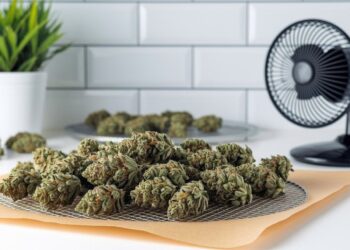You just bought some Rick Simpson Oil (RSO), or maybe you found an old bottle tucked away and wondered, Does this stuff expire? These are smart, responsible questions that anyone using cannabis oil should ask. As someone who’s used RSO for both wellness and chronic pain relief, I’ve seen firsthand what happens when oil is stored correctly, and when it isn’t.
RSO, like all cannabis concentrates, has a shelf life. Over time, it can degrade, lose potency, or even develop mold if mishandled. That’s why proper storage isn’t just a nice-to-know’ it’s essential.
In this article, we’ll answer your most pressing questions about RSO shelf life, backed by scientific sources and expert insights. We’ll walk you through how long RSO typically lasts, how to recognize spoilage, and how to store it for best results, so you can feel confident and safe every time you use it.
What is Rick Simpson Oil (RSO)?
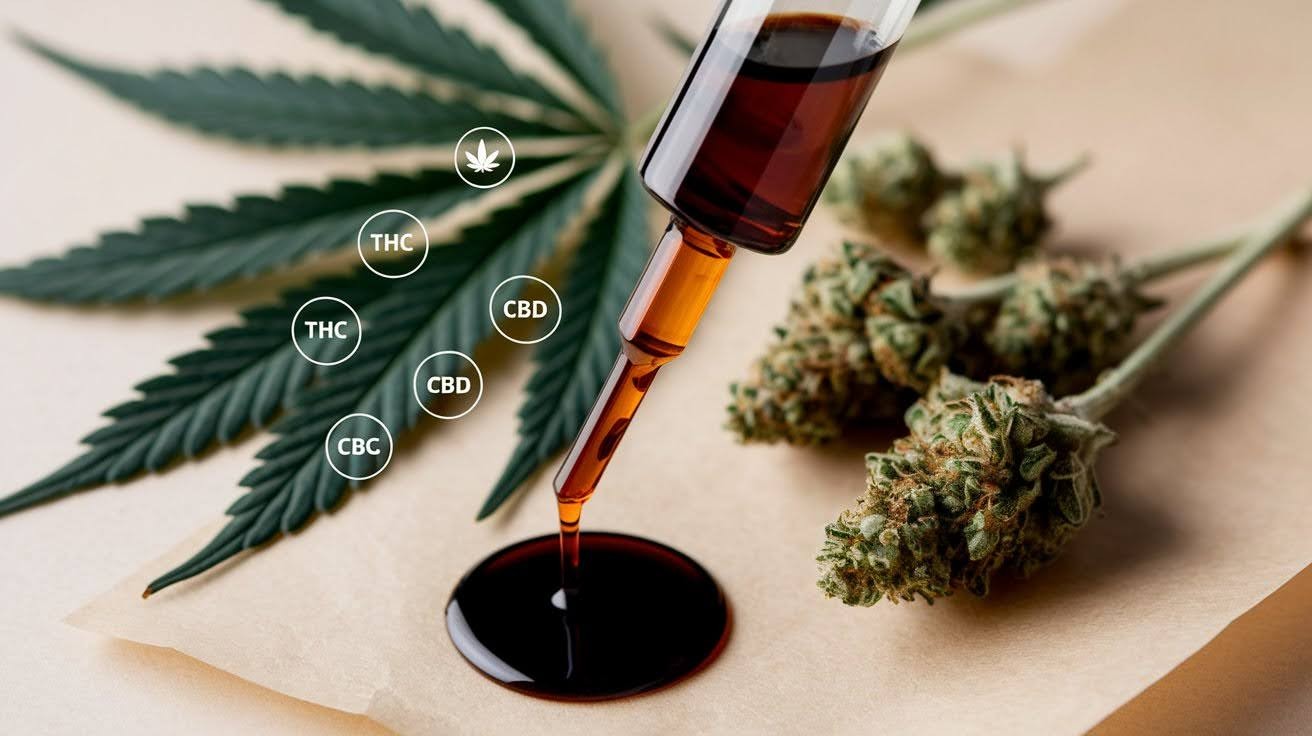
Rick Simpson Oil gets its name from Canadian engineer Rick Simpson. He created this cannabis extract in the early 2000s to treat his skin cancer. RSO is a full-spectrum cannabis extract packed with high levels of THC. But it’s not just THC you’re getting.
This thick, dark oil contains:
- Cannabinoids like CBD, CBG, and CBN
- Terpenes that add flavor and effects
- Other plant compounds that work together
The consistency? Think thick molasses or tar. It’s sticky, dark, and incredibly potent. Here’s where things get interesting. RSO is not your typical cannabis oil.
Hemp oil has high CBD and low THC. RSO flips this completely, high THC with moderate CBD levels. Regular cannabis oils are often diluted or processed differently. RSO stays concentrated and powerful.
The biggest difference? RSO keeps all the plant compounds intact. Unlike isolates that contain just one cannabinoid, RSO gives you the full plant experience. This means stronger effects and better therapeutic benefits.
Does RSO Expire?
RSO doesn’t last forever. Over time, its potency drops. Learn how storage affects shelf life and when it expires.
The Short Answer: Yes, But It’s Complicated
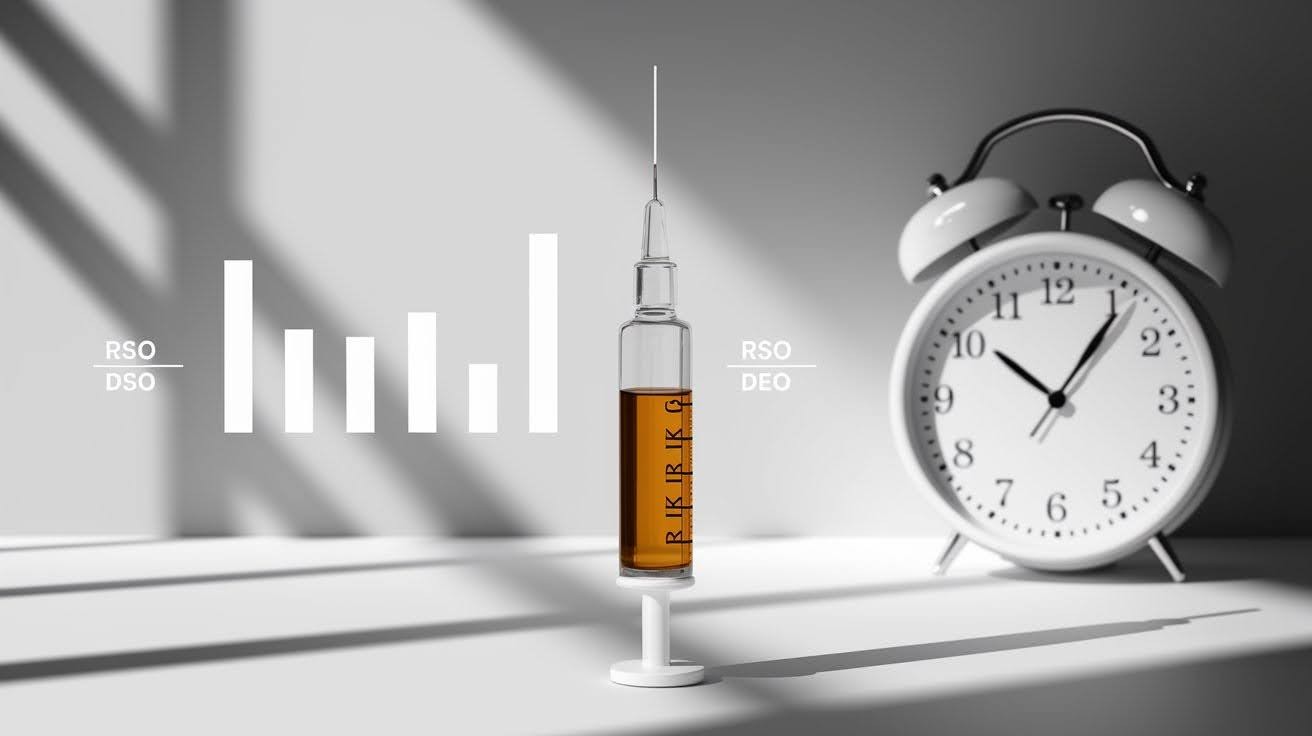
Yes, RSO does expire. But not like the milk in your fridge. You won’t wake up one day to find your RSO suddenly bad. Instead, RSO has an exceptionally long shelf life’ we’re talking months or even years when stored properly.
Think of it this way: RSO doesn’t spoil like food products do, no mold, no rotten smell, no immediate danger. What happens is much more gradual. Your RSO slowly loses its strength over time.
What “Expiration” Means for RSO
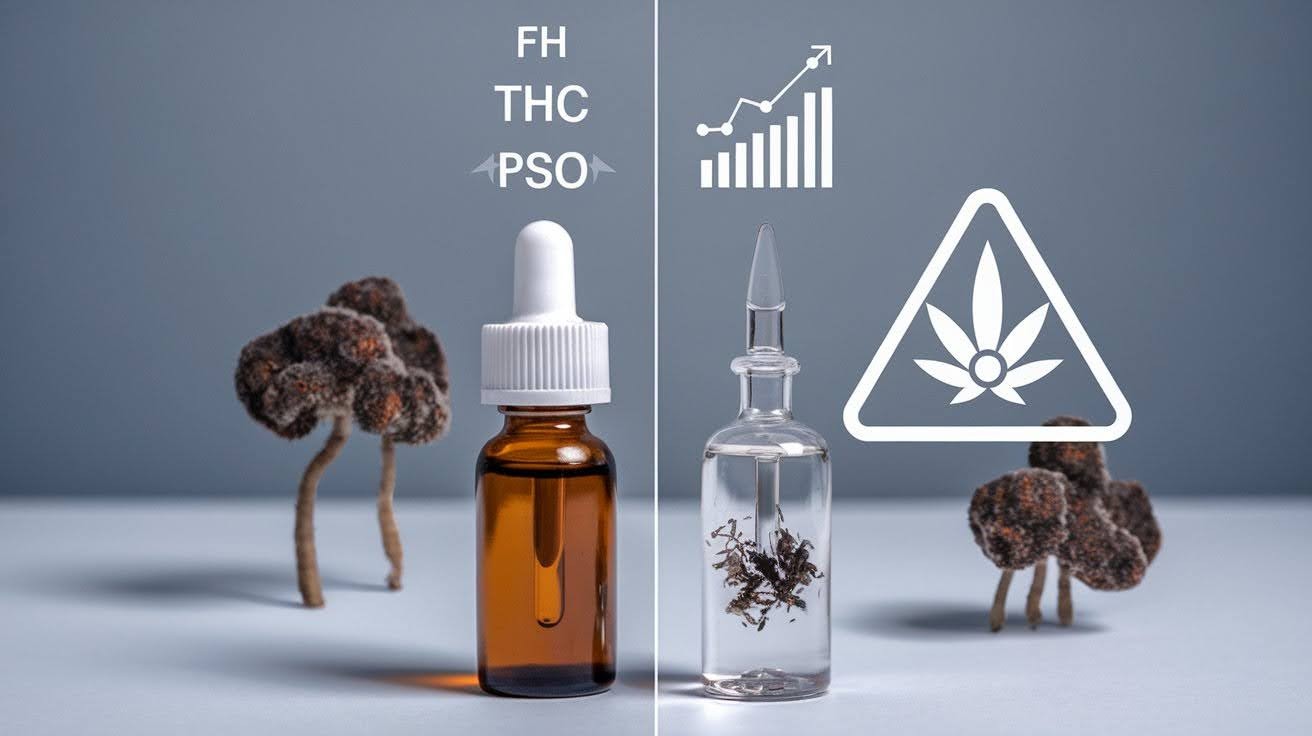
When I say RSO expires, here’s what’s happening: Your cannabinoids start breaking down. THC converts to CBN, which makes you sleepy instead of giving you the effects you want.
The therapeutic benefits you’re counting on? They get weaker and weaker. You’ll notice physical changes too:
- Color shifts from dark amber to brown or black
- Texture becomes harder or more brittle
- Consistency changes completely
But here’s the real concern. Improper storage opens the door to contamination. Bacteria, mold, or other nasties can move in and make your RSO unsafe to use.
RSO Shelf Life: How Long Does It Last?
Wondering how long RSO stays effective? Learn about its shelf life, proper storage tips, and signs it may expire.
Alcohol-Infused RSO
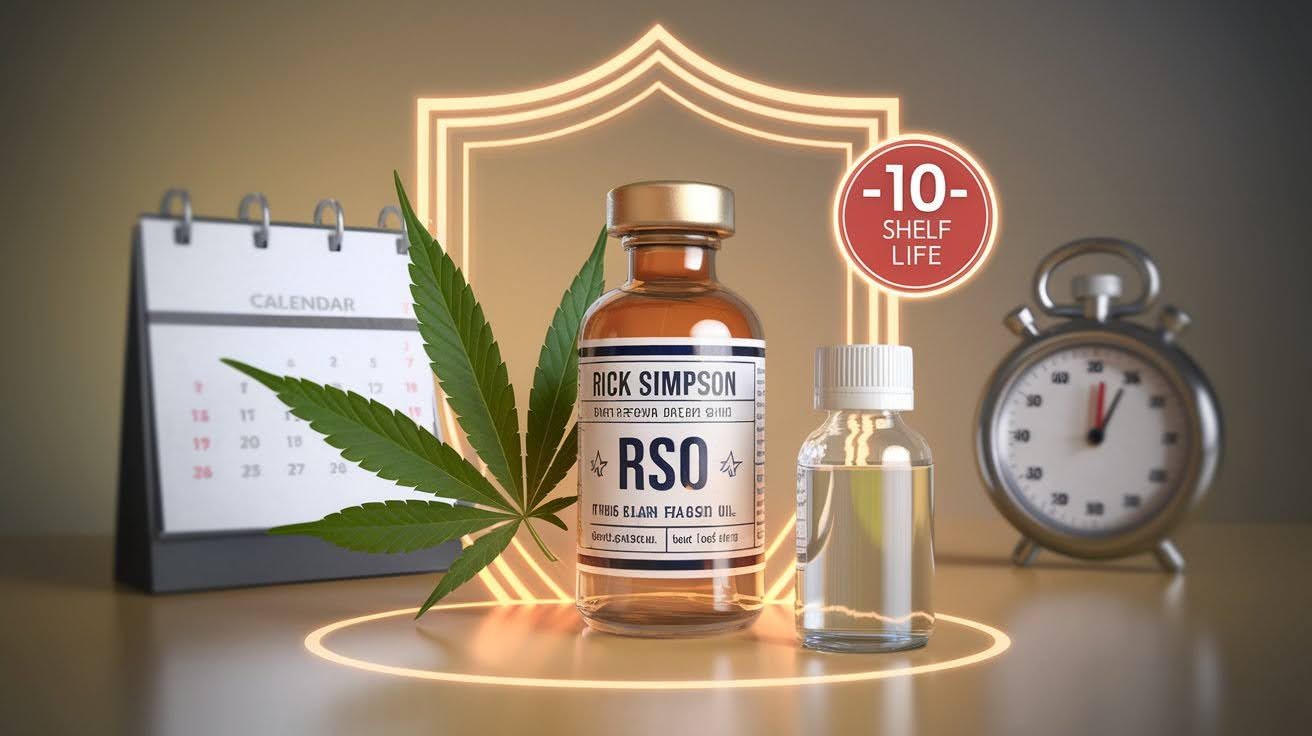
Here’s something that might surprise you. Alcohol-based RSO can last up to 10 years when you store it right. Why so long? Alcohol works like a natural preservative.
It fights off bacteria and keeps your RSO stable for years. This makes RSO the longest-lasting cannabis product you can buy. Nothing else comes close.
Oil-Based RSO
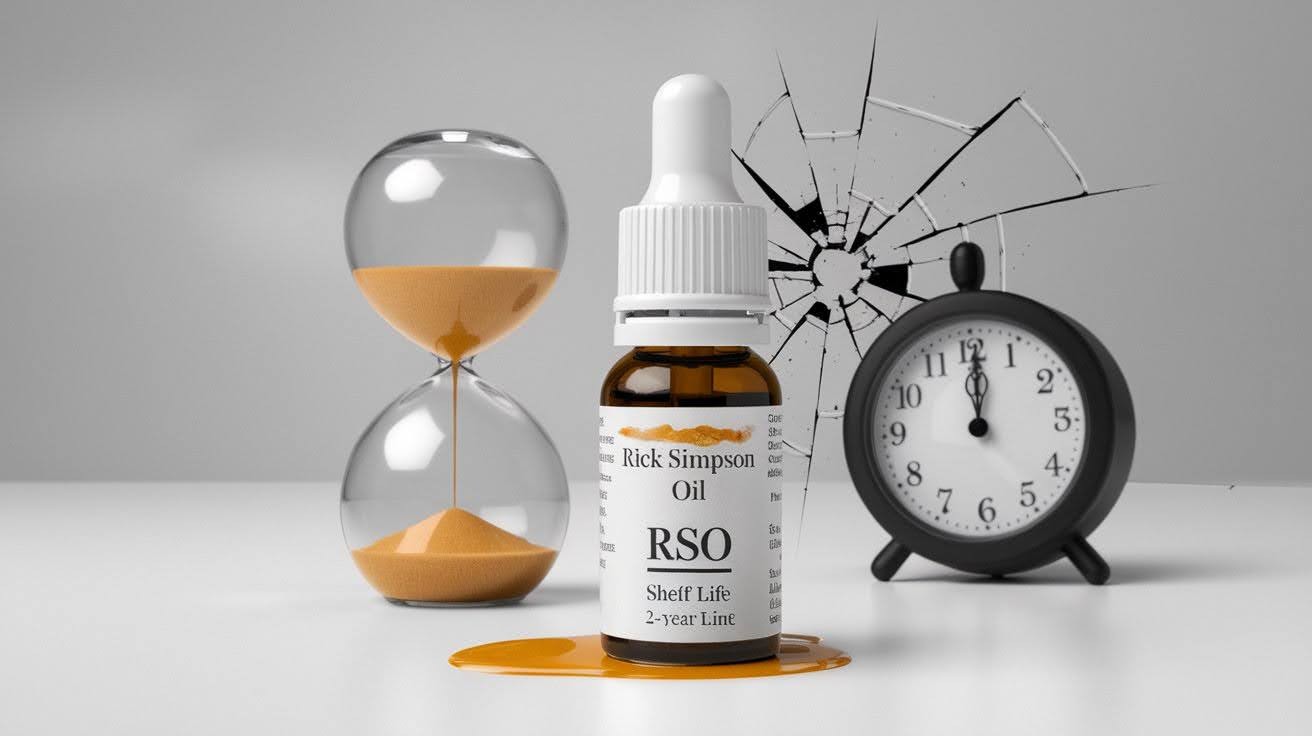
Oil-based versions don’t last as long. You’re looking at about 2 years of good quality. The carrier oil breaks down faster than alcohol does. This makes oil-based RSO more fragile and prone to going bad sooner.
Factors Affecting Shelf Life
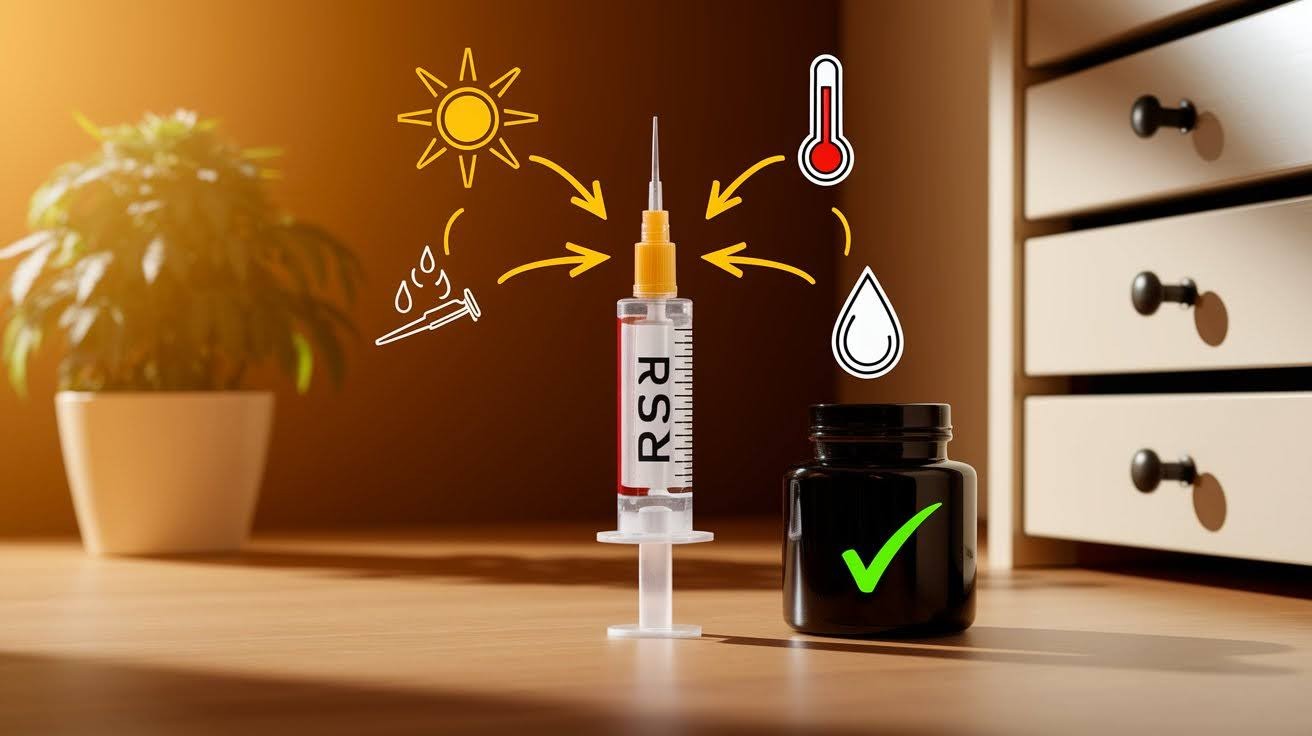
Your storage habits make a huge difference. Three things can destroy your RSO fast:
- Temperature swings: heat speeds up breakdown
- Light exposure: UV rays damage cannabinoids
- Moisture: humidity invites mold and bacteria
The container matters too. A tight seal keeps air out. Poor sealing lets oxygen in, which ruins your RSO faster. Starting with high-quality cannabis also helps your RSO last longer.
Quick Comparison with Other Cannabis Products
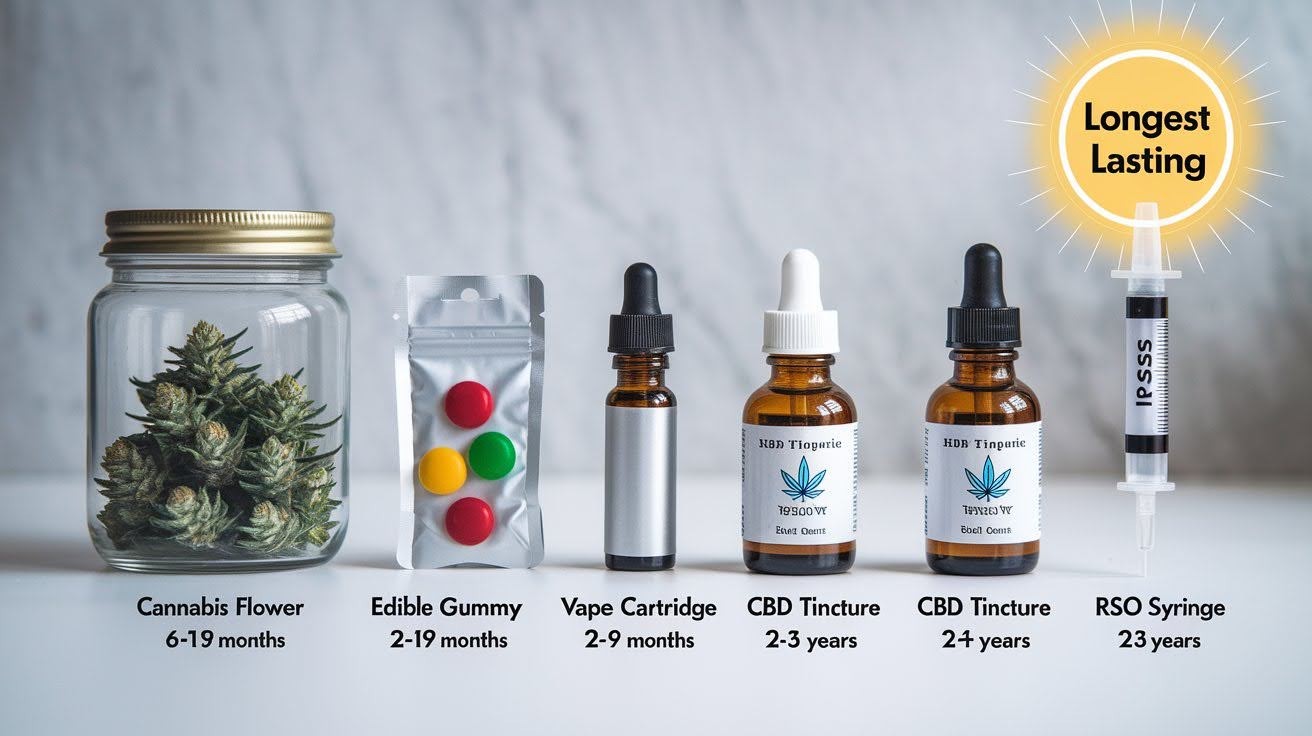
Let me put RSO’s shelf life in perspective:
- Cannabis flower: 6-18 months
- Edibles: 2 days to 9 months (depends on type)
- Vape cartridges: 2-3 years
- CBD tinctures: 2-10 years
- RSO: 2-10 years
RSO wins the longevity game. No other cannabis product stays potent for as long as properly stored RSO does.
Signs Your RSO Has Expired or Gone Bad
Not sure if your RSO is still good? Watch for changes in smell, texture, color, and effects as warning signs.
Visual Changes

Your eyes are your first line of defense. A good RSO should look consistent and clean. Watch for these warning signs:
- The color gets much darker than when you bought it
- Oil separates into different layers
- Texture becomes grainy or crystallized
- White fuzz or weird spots appear (that’s mold)
Fresh RSO has a smooth, even appearance. Any major visual changes mean trouble.
Smell and Taste Indicators

Take a sniff before you use your RSO. Fresh oil has a strong, earthy aroma reminiscent of cannabis. Bad RSO smells different:
- Original scent fades away completely
- Rancid or sour odors develop
- Musty basement-like smell appears
- Any smell that makes you wrinkle your nose
The taste changes, too. If it tastes off or unpleasant, don’t use it.
Potency Loss

This one’s tricky because it happens slowly. You might not notice at first. Signs your RSO is losing strength:
- The same dose doesn’t work like before
- You need more to get the same effects
- Therapeutic benefits disappear
- No psychoactive effects at all
Safety Red Flags

Some signs mean stop using your RSO immediately: Any visible mold growth is a hard no. Mold can make you seriously sick. If the consistency becomes totally different, like turning into liquid or hard chunks, something’s wrong. Trust your instincts. When in doubt, throw it out. Your health isn’t worth the risk.
Proper Storage Techniques for Maximum Shelf Life
Store RSO in a cool, dark place. Use airtight glass containers. Avoid heat, light, and moisture to preserve potency longer.
Ideal Storage Conditions
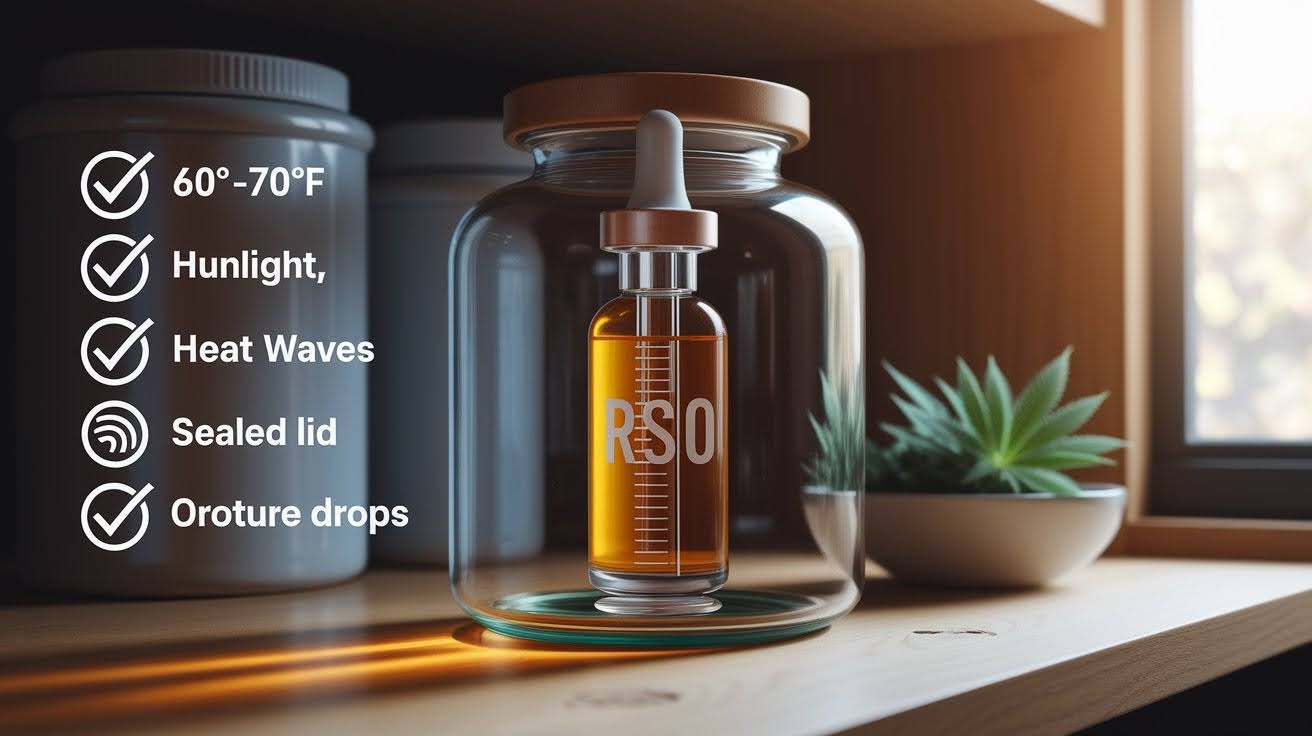
Where you store your RSO makes all the difference. Think of it like fine wine’ it needs the right environment to stay good. Your RSO needs cool temperatures between 60-70°F (15-21°C).
Complete darkness is essential, too’ no sunlight or bright lights allowed. Keep humidity levels low, around 60% and make sure there’s zero air exposure. Heat destroys cannabinoids fast. Light breaks them down, too.
Moisture invites mold and bacteria to grow in your oil. A bedroom closet or medicine cabinet works great. Your kitchen doesn’t’ there’s too much heat and light from cooking. The bathroom is also a bad choice because of the steam and temperature changes.
Best Storage Containers
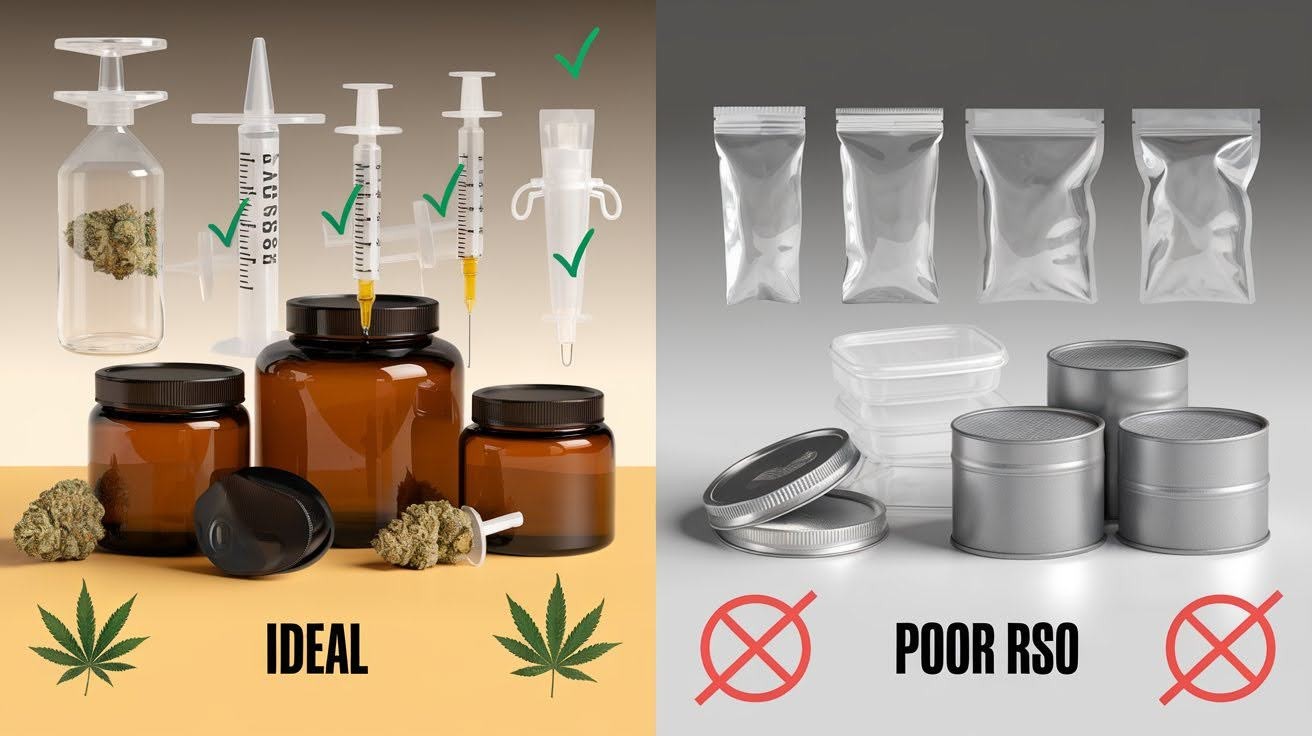
Glass beats plastic every time. Plastic can break down your RSO over time and contaminate it. Dark glass jars with tight lids work perfectly. You can also use the original syringes if the seal still works properly.
Amber glass containers from dispensaries are another great option. For long-term storage, vacuum-sealed bags give you the best protection. Clear glass is okay if you keep it in total darkness. But dark glass gives you extra protection against light damage.
Never use regular plastic bags or containers. They’re not airtight and can contaminate your RSO. Metal containers aren’t good either because they can react with the oil.
Refrigeration Considerations
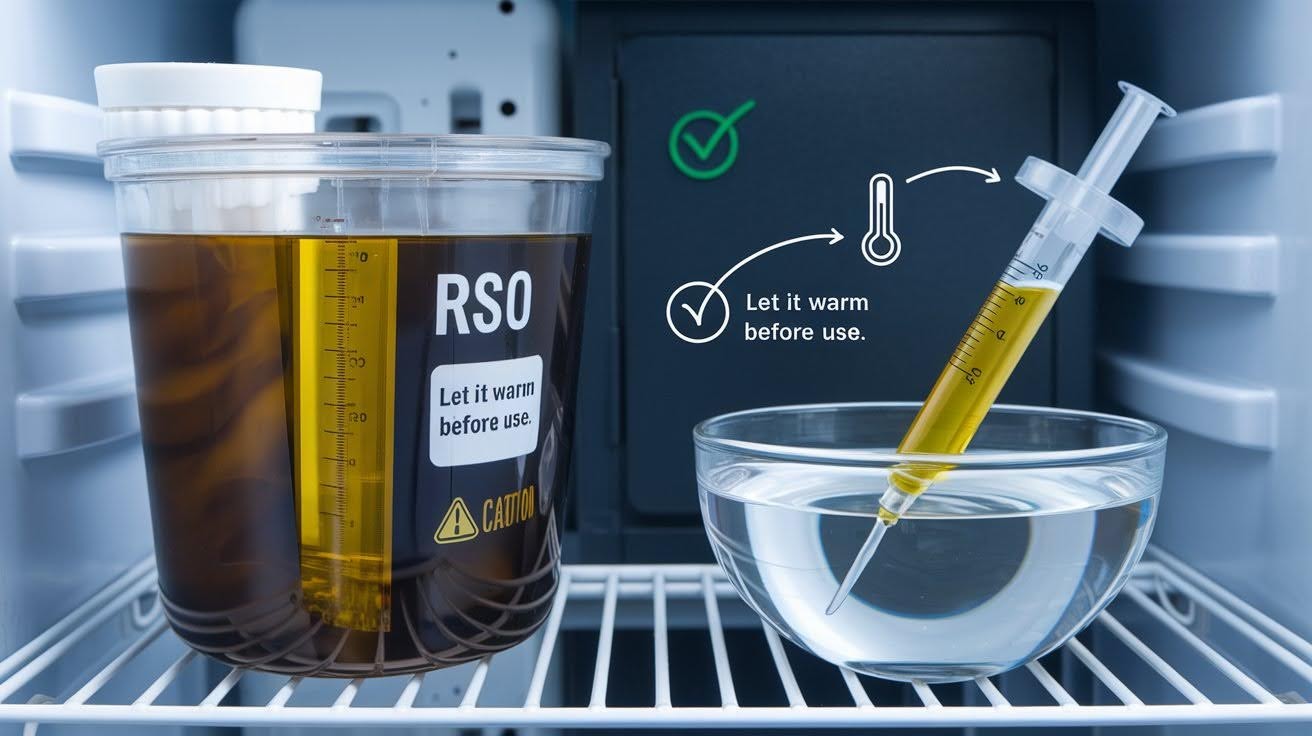
Should you put RSO in the fridge? It can help your oil last longer, but there’s a catch.
Cold temperatures will make your RSO thick and hard to use. It might turn almost solid, making it tough to get out of the container.
If you refrigerate it, warm it up safely first. Hold the container in your hands for a few minutes or place it in warm (not hot) water. Never use a microwave or direct heat.
Room temperature storage works fine for most people. Your RSO will stay good without refrigeration if you follow proper storage rules. The key is avoiding temperature swings that can damage your oil.
What to Avoid

These storage mistakes will ruin your RSO fast. Never leave it in direct sunlight, UV rays destroy cannabinoids quickly. Keep it away from heat sources like stoves, radiators, or heating vents. High temperatures are RSO’s worst enemy.
Don’t store it in your bathroom because of the humidity from showers. Your car is terrible too’ temperatures swing from freezing to blazing hot. Stop opening the container frequently. Every time you expose RSO to air, it degrades a little more. Only open it when you need to use it.
Safety Considerations and Best Practices
Always use clean tools when handling RSO. Keep out of children’s reach. Avoid high heat. Check for changes before each use.
Using Expired RSO
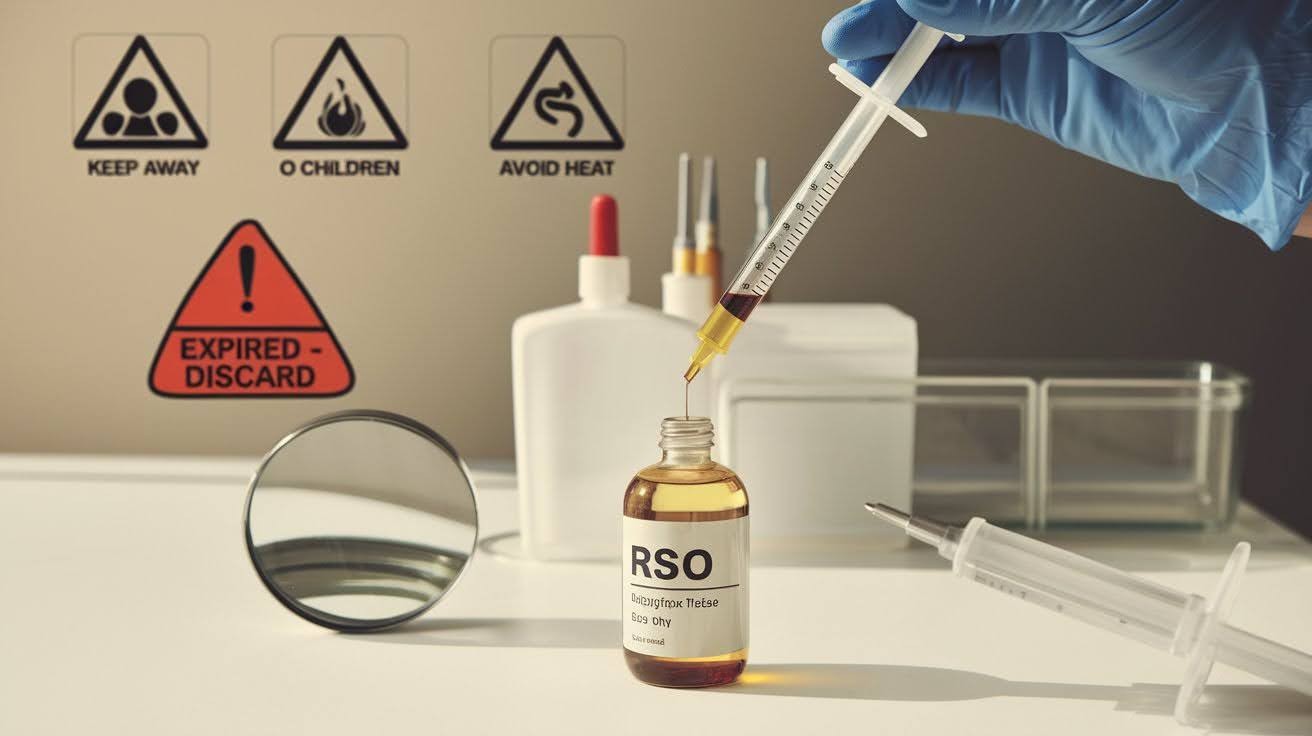
Here’s some good news. Old RSO usually won’t hurt you, but it won’t help much either. The biggest risk is wasting your money on weak oil. Expired RSO loses its therapeutic power over time.
You might take your normal dose and feel nothing. When should you throw it out? If it’s been sitting around for years past its prime, just get rid of it. If you see any mold or weird changes, toss it immediately. Your health is worth more than saving a few dollars.
Contamination Risks
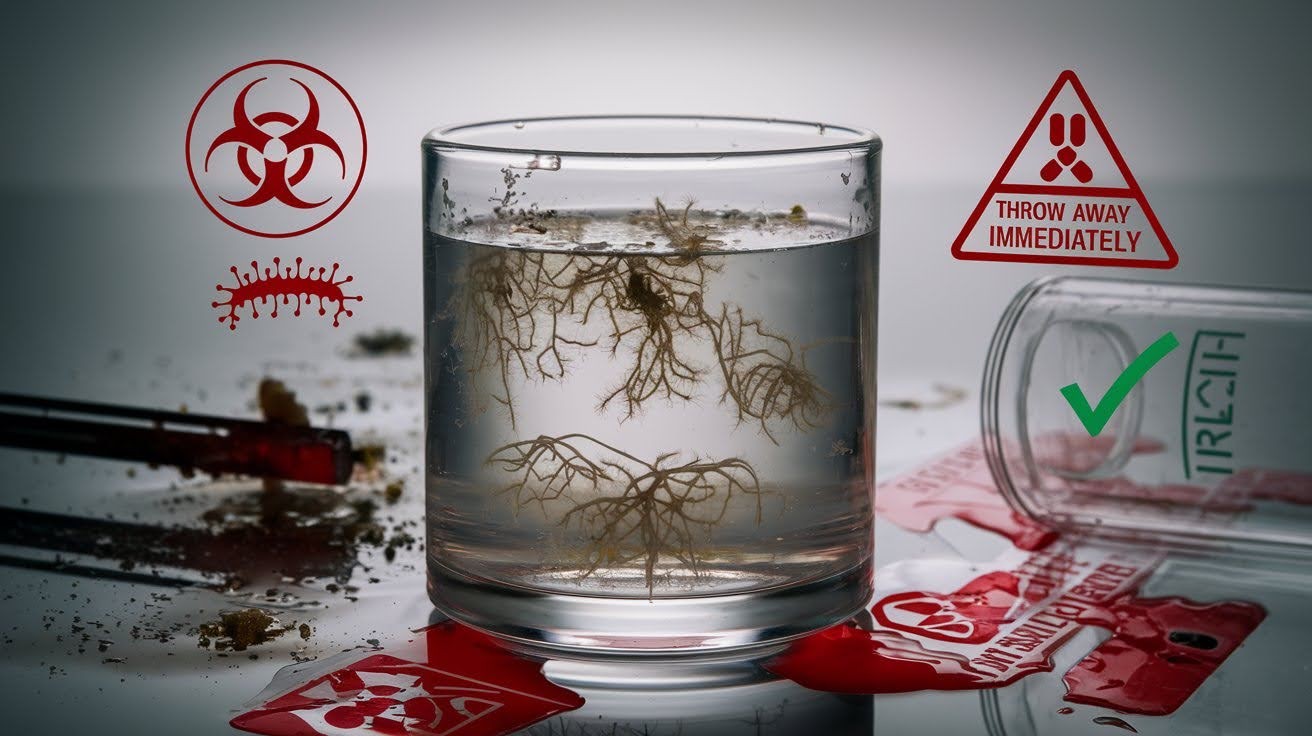
Mold is your biggest worry with old RSO. It grows when moisture gets into your container or when you store it in humid places. Bacteria can also move in if your RSO gets contaminated. This happens when you use dirty tools to scoop it out or leave the container open.
Red flags that mean throw it away right now: any fuzzy growth, weird colors that weren’t there before, or smells that make you gag. Don’t take chances with contaminated oil.
Quality Assurance Tips
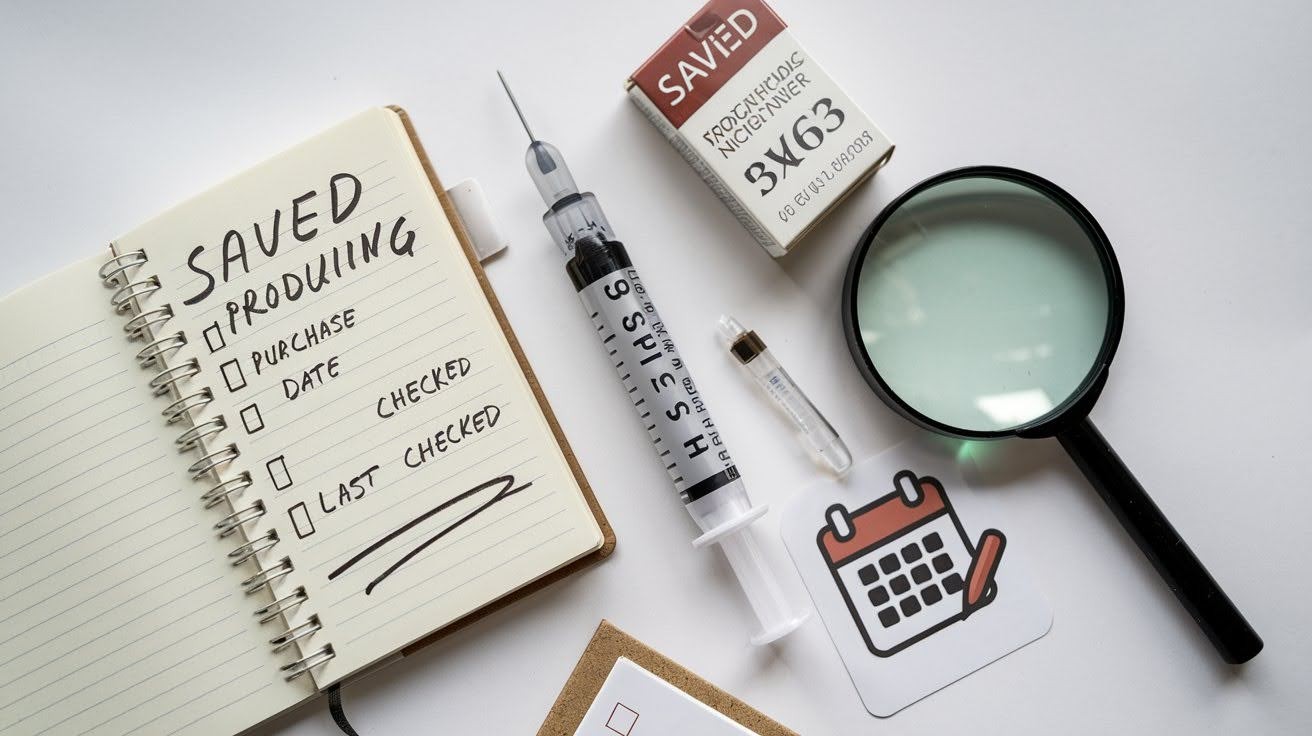
Make checking your RSO a habit. Look at it every few weeks for changes in color, texture, or smell. Write down when you bought it. Keep a simple log with purchase dates and what you notice over time.
Save the packaging from dispensaries. Batch information helps if you need to track problems or check recall notices later.
Conclusion
Now you know the answer to “Does RSO expire?” Yes, but it lasts much longer than most cannabis products when stored properly. The key takeaways are simple: alcohol-based RSO can last up to 10 years, while oil-based versions stay good for about 2 years.
Store your RSO in a cool, dark place using airtight glass containers. Watch for visual changes, off smells, or reduced potency as signs that it’s time to replace it. You’re now equipped to keep your RSO fresh and potent for as long as possible, no more guessing games or wasted medicine.
Have questions about your specific RSO storage situation? Drop a comment below, I’d love to help you get the most out of your cannabis oil investment.
Frequently Asked Questions
Does RSO expire?
Yes, RSO does expire, but it has a long shelf life. Alcohol-based RSO lasts up to 10 years, while oil-based versions last about 2 years when stored properly.
How can I tell if my RSO has gone bad?
Look for color changes, mold growth, off smells, or separation. If it smells rancid or shows visible contamination, discard it immediately for safety.
Can I use expired RSO safely?
Expired RSO is generally safe but less effective. You’ll experience reduced potency and therapeutic benefits. Avoid using RSO with visible mold or contamination signs.
What’s the best way to store RSO?
Store RSO in dark glass containers at 60-70°F, away from light and moisture. Keep containers tightly sealed and avoid temperature fluctuations for maximum shelf life.
Should I refrigerate my RSO?
Refrigeration can extend shelf life, but makes RSO thick and hard to use. Room temperature storage in proper conditions is usually sufficient for most users.




